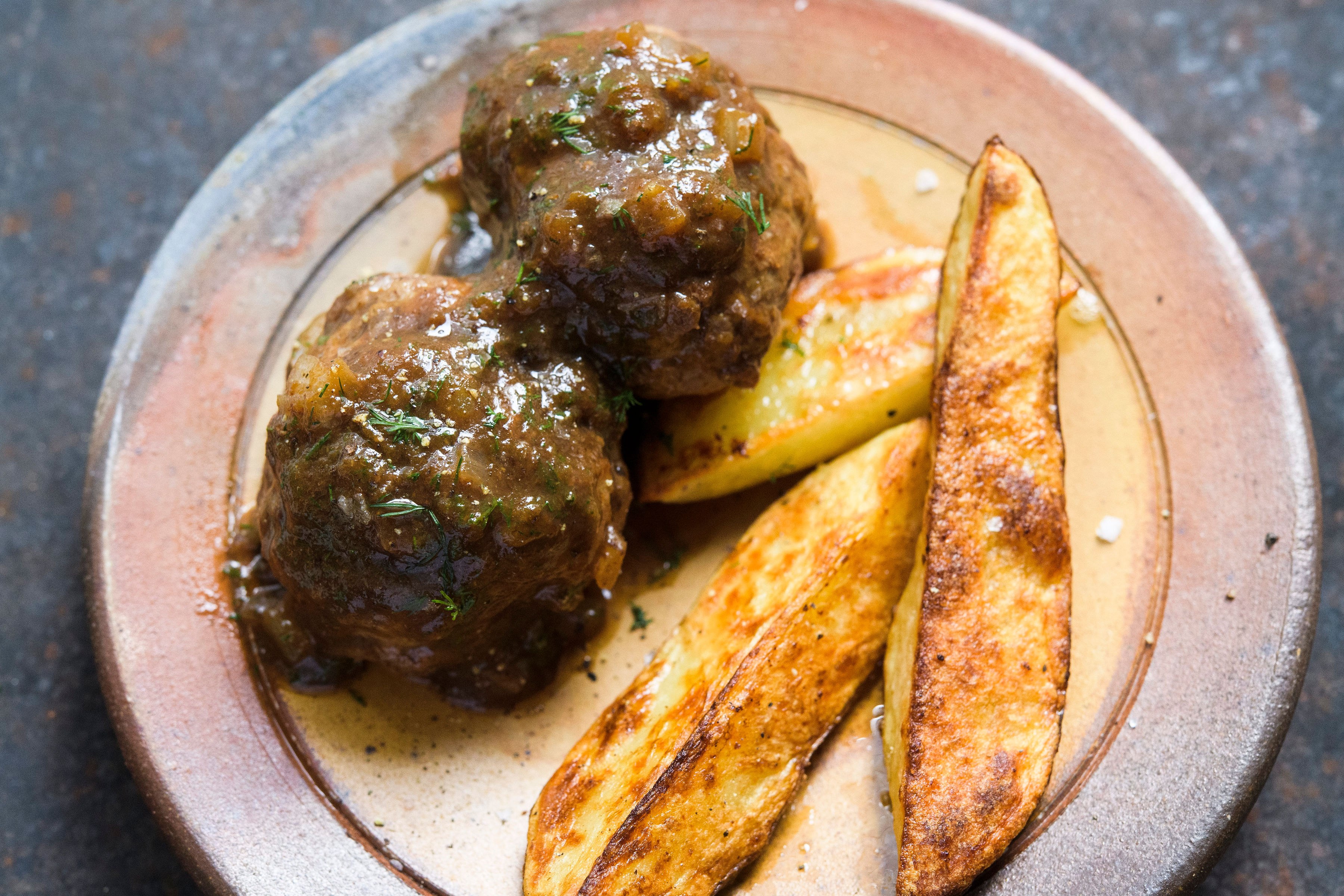The mayor starts the countdown as screeching children swirl amid a throng of hundreds gathered below the balcony of Merchtem city hall. Drie! Twee! Een! Gaan! A torrent is unleashed, hurled down and into the leaping crowd.
A torrent of 700 foil-wrapped meatballs, that is, thrown hilariously, raucously by members of the town council—and me—and triggering a minute-long frenzy. Youngsters collect them in sacks, grandmothers gather them in their shirts.
It’s playfully chaotic, as generations vie for one of 10 meatballs with a prize ticket inside. A quirky tradition in this town 20 miles from from Brussels, today it marks the end of the annual summer carnival, though originally it celebrated the end of World War II.
To me, it’s an impromptu stop on a four-day immersion into the Belgian meatball, a search for a national dish—tender rounds of pork and veal that expertly straddle lines. Between salty and sweet. Between north and south. Between French and Dutch traditions.
In the Dutch-speaking North of Belgium, butter before being topped with a heap of bright, sour cherries. They’re boulets in the French-speaking South, where they are baked in a dark, beer-based sauce sweetened by an apple-pear syrup.
All delicious, but neither an obvious fit for the lighter, bolder flavors we favor at Milk Street. But I suspected each had something to teach us. Could we borrow the best of both styles to build a better meatball back home?
St. Niklaas—The North
Ludo dergent drops golf ball-size meatballs into boiling water, waiting for them to float. He'd formed them minutes before, using a spoon. The meat, a 60-40 blend of pork and veal, is bound with egg and a sprinkling of breadcrumbs, seasoned only with salt and a generous scrape of fresh nutmeg.
The jovial retiree, with a wide grin and tortoiseshell glasses worked in restaurants growing up, then had his own for five years. Now, he’s in his son’s airy, modern kitchen in St. Niklaas, a small city near Antwerp. Once the meatballs float, they’re ready to be fried in a worn cast-iron skillet. Butter sizzles as a dark crust forms on them and the kitchen fills with the rich aromas of saturated fat and browning meat.
For the simple sauce, he drains the liquid from two jars of pitted sour cherries, or krieken, into a saucepan and adds sugar; later it’s thickened with cornstarch. Families typically use jarred cherries because the juice is a key ingredient in the sauce. Even those with a tree in the backyard start this recipe by preserving the fruit.
The cherries are added to the sauce at the last minute, just long enough to heat them while maintaining their luscious texture. Simple as that, the sauce is spooned over the meatballs, everything eaten lukewarm.
“It’s not anything spectacular, but it’s very authentic Belgian,” says Margie Nung, Dergent’s daughter-in-law. I disagree. They are delicious, buttery, moist and firm, drowning in pops of juicy cherries that cut through the fat and highlight the faintly sweet aroma of nutmeg.
Meatballs are tossed off the balcony into the crowd below.
A lucky catch.
In Belgium, people eat meatballs multiple times a week and even celebrate them at festivals.
Liège—The South
As my train heads south, the announcements switch from Dutch to French as we pass into the rolling farmland around Liège. Bales of hay and towering wind turbines dot the landscape; fields of ripening corn shimmer in the afternoon sun. The university town is a cultural hub that’s also known for sirop de Liège, a thick reduction of apple and pear puree. Its main use? Meatballs.
I find the boulets à la liégeoise I’m looking for at the contemporary Grand Café de la Gare, housed in a skeletal train station designed by Santiago Calatrava. I soon see why they send out more than 200 orders a week. Spooned out of a black Staub cocotte, the meatballs are a bit sweet, a bit salty, the sauce complex. As always in Liège, crispy fries with mayo are on the side.
“Our way is the only way. We can’t even imagine having meatballs with tomato sauce,” says manager Pierre Stassart, furrowing his brow and shaking his head. “It’s like in Italy if you ask for Parmesan for pasta with fish, they don’t give you the cheese. Here it’s the same. We don’t sell the meatballs any other way. No.”
Stassart’s chef is reluctant to share the exact recipe but lets many secrets slip. The meat is mixed by hand with egg, chopped onion, parsley, salt and a splash of milk, taking care not to overwork the meat. It’s rolled into a loose, knobby lump just smaller than a tennis ball, then flattened on one side so it won’t roll in the pan.
Dark brown ale forms the base of the sauce, which is sweetened with the sirop de Liège, which resembles apple butter. Raisins, chopped onion, mustard, bay leaf and minced thyme and parsley round it out. The meatballs are Once they’re cooked, the meatballs are removed from the pan, which is deglazed with water. The sauce reduces to a rich glaze that clings to the meatballs. Herbal, juicy and rich, they are perfect, a balance of sweet sauce and salty, tender meat. With apologies to the Flemish in the North, they’re the best meatballs I’ve ever had.
Milk Street

Back at Milk Street, we roughed out our blend of the two approaches. The jarred cherries of the North were hard to come by, but we liked their stovetop cooking method. The roasting of the South was fussy, but their simpler—and easier to replicate—fruit syrup-based sauce perfectly balanced the savory meatballs.
We found a worthy substitute for the sirop de Liège in prunes, which we plumped in beef broth, then pureed. Their deep flavor tasted more like the heavily reduced fruit syrup than pears or apples and mirrored the raisins used in many traditional recipes across Belgium.
For the meatballs themselves, we settled on a 50-50 blend of pork and beef; ground veal is hard to find in the U.S. and pork gave us the fat, tenderness and richer flavor we needed. And rather than using basic breadcrumbs as binding, we added flavor by mixing the meat with aromatic rye-caraway bread, as well as egg, dill, allspice and nutmeg, a nod to the Flemish version that paired well with our sauce.
The meatballs were browned in a skillet, then set aside while we prepared the sauce. After sautéing an onion, we deglazed the pan with just a bit of light Belgian beer—another nod to the South—then stirred in the prune puree, simmering it with bay and thyme. We returned the meatballs to the pan, reduced the heat and cooked them covered for a few minutes, then finished them uncovered to allow the sauce to thicken.
Setting the meatballs aside, the sauce further reduced, creating a rich glaze. Off heat, we stirred in more dill and a tablespoon of cider vinegar for brightness. Covered in the rich sauce, the meatballs were savory and just a bit sweet, echoing the flavors of both regions. Indeed, a better meatball. Just don’t throw it off a balcony.




